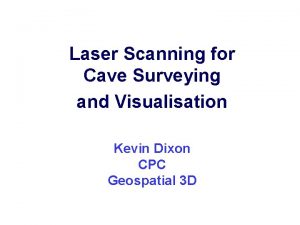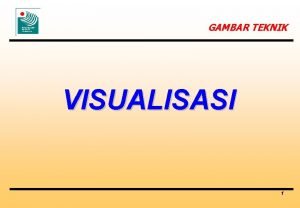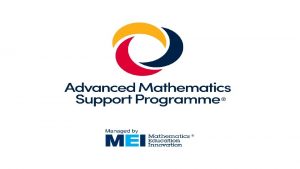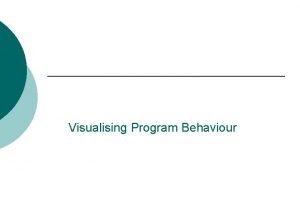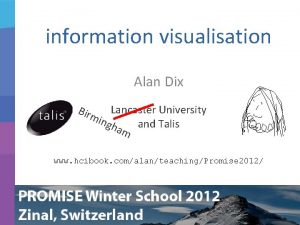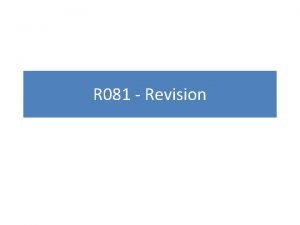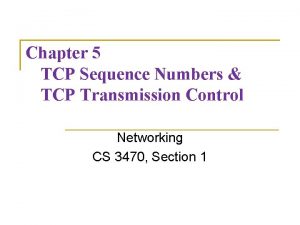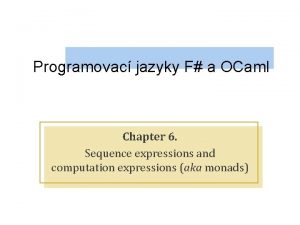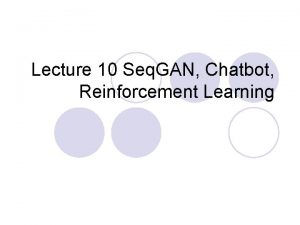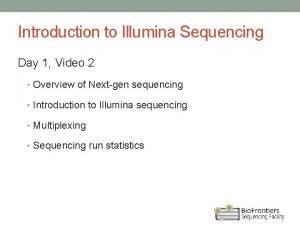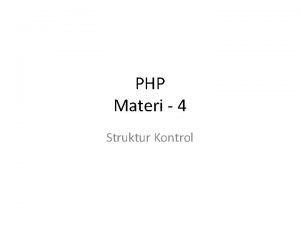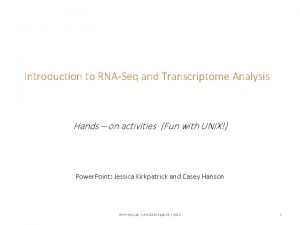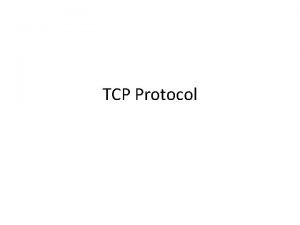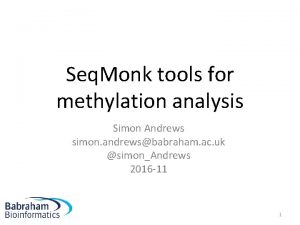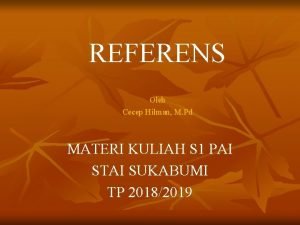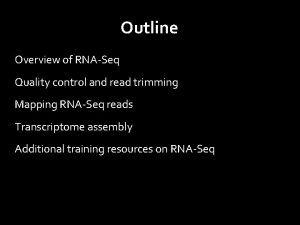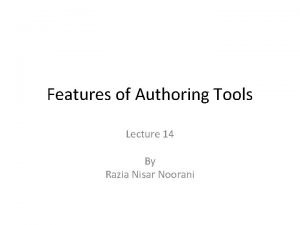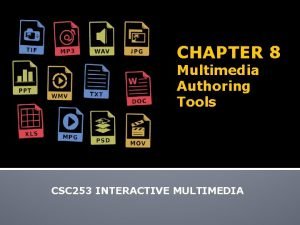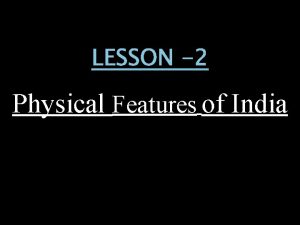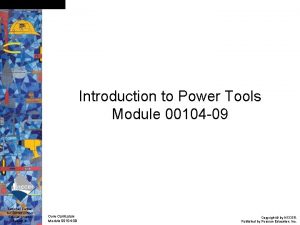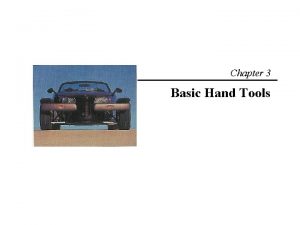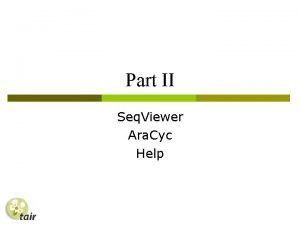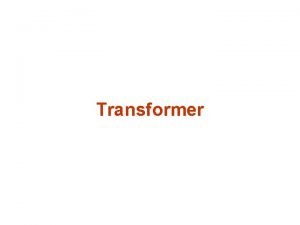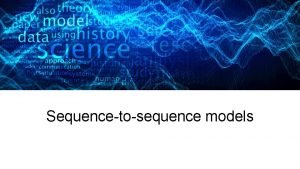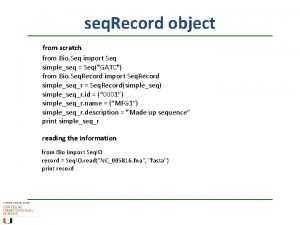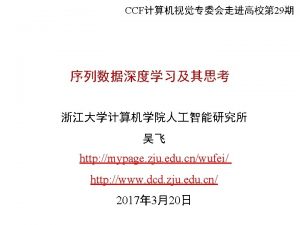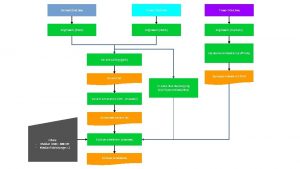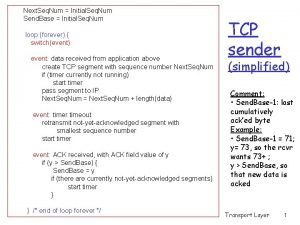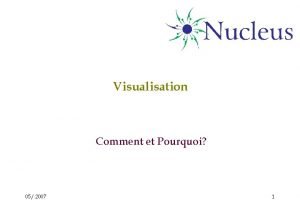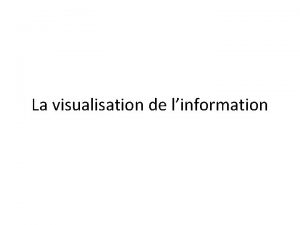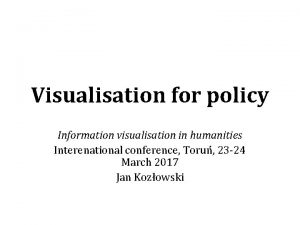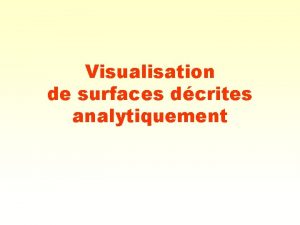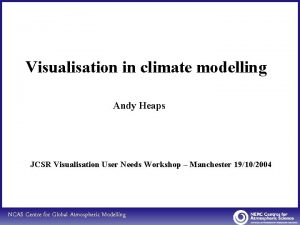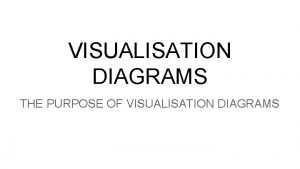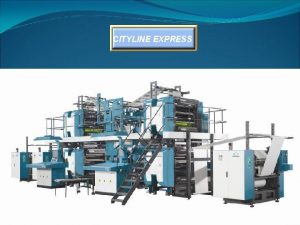Seq Express Introduction Features n Visualisation Tools q






























- Slides: 30

Seq. Express: Introduction

Features n Visualisation Tools q q n Analysis Tools q q q n Data: gene expression, gene function and gene location. Analysis: probability models, hierarchies and clusters. Cluster analysis, refinement and validation. Using mixture modelling. Graphs and Hierarchies. Data Tools q q q Data Import/Export tools (Remote access of GEO, local access of tab separated and MAGE format). Data Integration: optional underlying data and annotation database. Data Manipulation.

Seq. Express: Visualisation Tools

Visualisations n Data Visualisation: q q n Gene Expression; Gene Variance; Gene Function/Ontology; and Chromosome Features. Analysis Visualisations: q q q Hierarchies/Graphs; Probabilistic Methods; and Cluster Comparison.

Gene Expression Scatter Plots Parallel Plots Also: Histograms, Annotation lists and Gene Tables

Gene Variance Gene Spectrums Gene Clouds

Gene Ontology Visualisations Graphs Tree. Maps Tables

Chromosome Feature Visualisations

Data Analysis Probability Models Cluster Comparison Dendrograms

Example: Viewing Clusters A cluster has been selected in the gene tab. The genes are then selected in a scatter plot, a parallel plot and the histogram.

Example: Gene Function Selection The binding term has been selected from the results of an ontology term search. The binding term is then automatically selected in the Function tab, as well as the open Tree Map visualisation. All genes that have been annotated with the binding term are also selected in the parallel plot.

Example: Genome Location A combined expression profile and location-based cluster analysis has been performed and the results viewed. The parallel plot shows the similar expression profiles, whilst the two genome views show the locale of the genes. The genome view in the middle is set to auto -zoom, and so shows the locale in detail.

Example: Data Analysis A series of models have been generated, and the genes with a high probability of belonging to one of the models has been selected in the model viewer. The corresponding location of the genes and their expression profiles are then shown

Summary n Number of visualisations available to support variety of tasks: n n n n Expression Ontology (plus pathway and protein-protein interaction) Location Hierarchies Cluster comparison Variance Probability-theory Visualisations inter-linked

Seq. Express: Analysis Tools

Analysis Tools 1: Clusters, Hierarchies and Concepts n Clustering: q Distance based Refinement (ontology or model based). q Validation (C-Index) q n n Hierarchies: SDD*, Hierarchical Projection: q q Covariance*: eigen(covar(A)) or A=USVT Co-occurrence*: P(g, e)=P(g)ΣP(e|z)P(z|g) *Used for global/enterprise-wide information retrieval

Cluster Distances Expression Pearson, Cosine Euclidian, Manhattan. Function Information theory: 2*N 3/(N 1+N 2+2*N 3) Location Intra gene distance to feature

SAGE: Semi Discrete Decomposition • Immunity to outliers • Uses local density • Describes both experiments and genes • Hierarchical description • Stencils means that fold-in possible • Highly scalable

Analysis Tools 2: Models and Graphs Multi-factor analysis to identify complex features within the data (e. g. genes which have both a similar expression profile and are located on the same part of a chromosome) n n Graphs: Two factor analysis using (1)Graph Connectivity and (2) Edge Length. Models: N-factor analysis using product rule: P(A, B|C)=P(A|BC)*P(B|C).

Models: Discovery Different models can be found, and altered using energy parameters and tempering.

Spline (beta 0. 1) Normal (beta 0. 1) Linear (beta 0. 6) Cosine (beta 1. 1)

Models: Usage n n n Clusters generation: High probabilities equate to cluster membership. Fitting data: Use normal tissues to fit models to genes, use disease tissues to fit genes to models. Changed behaviour equates to likelihood of model transition. Combining models: complex feature identification (given feature X on condition Y).

Graph: Discovery n Graph connectivity equates to: q q q n Edge Distance equates to: q q q n MST of expression values Sub-graphs of the gene ontology Chromosome relationship Expression distance Network (ontology) distance Linear chromosomal distance Graph partitioned: q q regular (using Metis) irregular (Min/Max)

Analysis: Summary n n n Desktop analysis. Number of techniques available. Techniques can be customised for different data sets (e. g. organism, array type). Borrows heavily from Information Retrieval. Probabilistic techniques show most promise.

Seq. Express: Data Tools

Data Analysis n Data Import/Export tools: q q q n Data Integration: data and annotation database. q n Remote access of GEO (one click access), Import tab separated and MAGE format. Export tab separated and Bioconductor format Automatic and configurable annotation mapping (e. g. SAGE tag to locuslink (entrez gene? ) to unigene) Data Manipulation: transformation, filtering and constraining

Data Integration: GEO

Data Integration: Annotation Builder

Seq. Express: Summary

Summary n n n Written in C#, is free and runs under windows. Not associated with any academic institution, funding body or commercial organisation. Development is still ongoing. Plan to develop to the Expression Application Class Specification. Looking for employment in Seattle…
 Pre production visualisation diagram
Pre production visualisation diagram Total station visualisation
Total station visualisation Visualisasi isometrik
Visualisasi isometrik Polychromatic lustre in complicated cataract
Polychromatic lustre in complicated cataract Mona chalabi charts
Mona chalabi charts Visualisation
Visualisation Visualisation
Visualisation R081 revision
R081 revision Karn partridge algorithm
Karn partridge algorithm Ocaml seq
Ocaml seq Chatbot reinforcement learning
Chatbot reinforcement learning Illumina sequencing chemistry
Illumina sequencing chemistry Index.php?seq=
Index.php?seq= Tuxedo suite rna seq
Tuxedo suite rna seq Tcp header format
Tcp header format Seq monk
Seq monk Seq artinya
Seq artinya Composite structure diagram
Composite structure diagram Rna-seq quality check
Rna-seq quality check Web authoring software features
Web authoring software features Card based authoring tools
Card based authoring tools Sewing tools measuring tools
Sewing tools measuring tools Introduction of physical features of india
Introduction of physical features of india Nccer power tools
Nccer power tools Power tool quiz
Power tool quiz Introduction of hand tools
Introduction of hand tools Nccer module 3 hand tools
Nccer module 3 hand tools 00104 power tools
00104 power tools Nccer introduction to hand tools
Nccer introduction to hand tools Module 3 introduction to hand tools test
Module 3 introduction to hand tools test Basic tools and basic hand operations
Basic tools and basic hand operations

